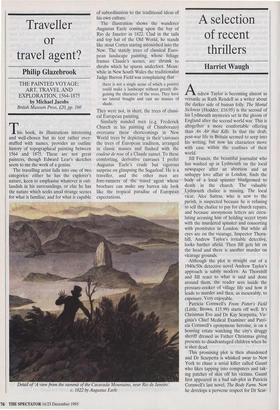Traveller or travel agent?
Philip Glazebrook
THE PAINTED VOYAGE: ART, TRAVEL AND EXPLORATION, 1564-1875 by Michael Jacobs British Museum Press, £20, pp. 160 This book, its illustrations interesting and well-chosen but its text rather over- stuffed with names, provides an outline history of topographical painting between 1564 and 1875. These are not great painters, though Edward Lear's sketches seem to me the work of a genius.
The travelling artist falls into one of two categories: either he has the explorer's nature, keen to emphasise whatever is out- landish in his surroundings, or else he has the nature which seeks amid strange scenes for what is familiar, and for what is capable of subordination to the traditional ideas of his own culture.
The illustration shows the wanderer Augustus Earle coming upon the bay of Rio de Janeiro in 1822. Clad in the tails and top hat of the Old World, he stands like stout Cortes staring astonished into the New. The stately trees of classical Euro- pean landscape painting, whose foliage frames Claude's scenes, are shrunk to shrubs which he spurns underfoot. Mean- while in New South Wales the traditionalist Judge Barron Field was complaining that
there is not a single scene of which a painter could make a landscape without greatly dis- guising the character of the trees. They have no lateral boughs and cast no masses of shade.
They were not, in short, the trees of classi- cal European painting.
Similarly minded men (e.g. Frederick Church in his painting of Chimborazo) overcame these shortcomings in New World trees by depicting in theiecanvases the trees of European tradition, arranged in classic masses and flushed with the couleur de rose of a Claude sunset. To these comforting, derivative canvases I prefer Augustus Earle's crude but vigorous surprise on glimpsing the Sugarloaf. He is a traveller, and the other men are fore-runners of the travel agent whose brochure can make any barren isle look like the tropical paradise of European expectations.
Detail of 'A view from the summit of the Cacavada Mountains, near Rio de Janeiro, c. 1822 by Augustus Earle










































































































 Previous page
Previous page